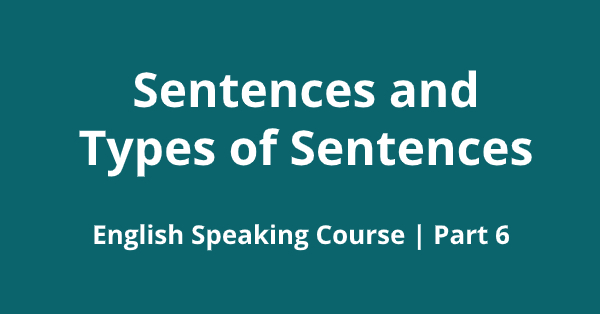What is a sentence?
A sentence is a collection of words that make sense. An arrangement of words to communicate a message is known as a sentence. A sentence should always make sense. Types of Sentences help us recognize the sentence structure. In essence, a group of words that don’t make sense can’t form a sentence.
For example:
I have an apple. (It makes sense and is a complete sentence.)
Apple has an I. (It doesn’t make sense and is incomplete, even if it’s made of the same words.)
Further, a sentence must always end in a period, a question mark, or an exclamation point. You can join two sentences using conjunctions. Also, the first letter of every sentence must be capital. Also, the type of punctuation depends on the type of sentence. Learning about different types of sentences will help you understand which punctuation to use in which case. let’s understand types of sentences given below.
Types of sentences
Let us learn about the different types of sentences. Sentences are of various types. We broadly categorize them into four types depending on their usage.
- Assertive sentences or declarative sentences
An assertive sentence tells the reader a fact, idea, or information.
For example:
- I am going to play outside.
- She is not going to school.
- I had sandwiches for breakfast.
Note that all the above sentences end with a period because they are facts and information.
- Imperative sentences
You write an imperative sentence to request, command or allow.
For example:
- Sit down.
- Let us go.
- Come here.
- Don’t do that.
These sentences also end with a period.
- Interrogative sentences
Interrogative sentences are also known as questions. In essence, when you ask someone a question, it is known as an interrogative sentence. Further, an interrogative sentence should always end in a question mark.
For example:
- Where are you going?
- When will you return?
- What is the time?
- Do you have any hobbies?
- What do you want?
- Is your mother at home?
- Can we go out?
- Exclamatory sentences
When you want to express excitement or eagerness, you end the sentence with an exclamation mark. In addition, it allows the reader to understand the emotions behind the sentence. Also, you can use an exclamation mark to lay emphasis on a sentence.
For instance:
- Thank god!
- Oh, dear!
- Alas!
- Sigh!
- Wow!
In addition, you can also use an exclamatory mark for normal sentences on which you want to give emphasis.
For instance:
- Don’t go there!
- Why did you do that! (Note that this sentence can also end with a question mark.)
- How dare you!
- Look at him!
- I can’t believe this!
- What is this!
- I am so happy!
- I am on cloud nine!
- Affirmative sentences
A sentence that is a positive response is known as an affirmative sentence.
For example:
He is a good boy.
She is a good student.
- Negative sentences
A sentence that gives a negative response is known as a negative sentence.
For example:
He is not a good boy.
She is not a good student.
- Affirmative interrogative sentences
A sentence that asks a question about an affirmative sentence is known as affirmative interrogative.
For example:
Is he a good boy?
Is she a good student?
- Negative interrogative sentences
A sentence that asks a question about a negative sentence is known as negative interrogative.
For example:
Is he not a good boy?
Is she not a good student?
These were the various types of sentences that you come across every day. Understanding the different types of sentences will help you use them properly in everyday conversations.
t

